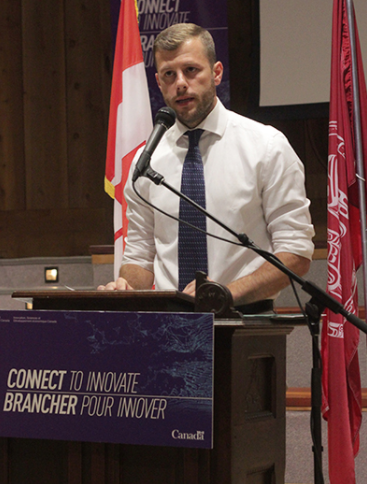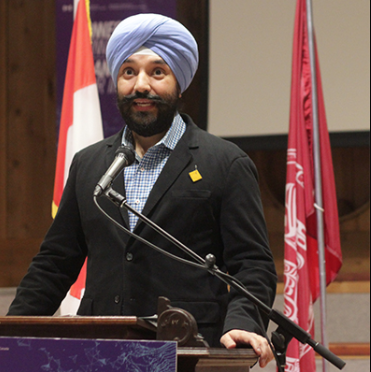
Haida Gwaii homes to get high-speed fibre optic internet
Thanks to funding announced Tuesday by the Canadian and B.C. governments as well as Gwaii Trust, local internet provider Gwaii Communications will soon start extending the islands’ fibre-optic internet network and offering free “last-mile” hook-ups to 341 homes outside the larger villages.
Every home in Port Clements, Sandspit, Lawn Hill, and Miller Creek will be eligible, along with 44 homes in Tlell and all the homes in Tow Hill before the end of the paved section of Tow Hill Road.
“If people choose to get hooked up, the drop will be for free,” says Joe Lavoie of Gwaii Communications, which applied for the funding through Canada’s Connect to Innovate program.

Joe Lavoie of Gwaii Communications. Ten years after it was founded by his brother Jeff as Lavoie Wireless, Gwaii Communications has grown from serving Old Massett and Masset to providing telecommunications services across all of Haida Gwaii. “We employ locally, invest locally, and we serve locally,” said Joe. (Andrew Hudson/Haida Gwaii Observer)
The project includes a subsea fibre-optic link between Graham and Moresby Islands, which Gwaii Communications hopes to have installed by a specialized boat and dive crew at the same time that BC Hydro installs new power cables between the islands, likely in July.“It’s an unreal opportunity for everyone,” he said. “It’s for the good of the whole island.”
Like a landline phone service, individual homes will connect to the network using fibre-optic lines hung on telephone poles. Those “last-mile” hook-ups will connect to the underground fibre-optic mainline that the GwaiiTel Society extended from Old Massett to Skidegate in 2016 (It is through GwaiiTel that the Gwaii Trust Society will contribute $500,000 to the project, as a stand-alone grant).
As well as internet, new customers will be able to sign up for digital TV and phone services through the same connection.
The project will connect most but not all homes on the islands — a step that could cost another $4 to $5 million. Half of Tlell will be left out for now, as well as some hard-to-reach houses in larger villages, such as Queen Charlotte. Every home that can connect to the fibre-optic system will need to switch from a wireless to a wired connection.
Haida Gwaii, BC
Three or four years from now, the whole Haida Gwaii network be connected to the mainland B.C. network by a coastal subsea cable rather than by a microwave radio link over the Hecate Strait. Until then, the network may be vulnerable to slowdowns as more homes get connected. GwaiiTel had applied for a third set of microwave radio dishes for the radio link, but no such funding was announced on Tuesday.
Still, the project will create a reliable high-speed connection between Graham and Moresby, and spare up to 341 homeowners “last-mile” hook-up costs that might have run as high as $6,000 to $9,000.
Also, as Minister Navdeep Bains pointed out while announcing the project in the Haida Heritage Centre, it means every Haida Gwaii library, school, hospital, and health centre will be connected.

Navdeep Bains, Canada’s minister of innovation, science, and economic development. (Andrew Hudson/Haida Gwaii Observer)
Doctors will be able to arrange remote visits with patients, he said, and local students of all ages will be able to connect with their off-island peers as well as gain easier access to higher education. For local businesses, too, high-speed internet will allow access to global markets and opportunities for new businesses and careers here.“The benefits will be critical,” said Bains, Canada’s minister of innovation, science, and economic development.
“Every child who can do school assignments online is potentially one more software developer in the country,” said Bains.
“And as you know, every sector of our economy is becoming more and more digital.”
Bains said it was appropriate to announce the project in the Haida Heritage Centre at Ḵay Llnagaay, where he was welcomed by Haida hereditary chief Gaahlaay, Lonnie Young.
“This territory has been a place of meeting and connections between people, both Indigenous and non-Indigenous for many, many years,” Bains said.
“That makes it, in my opinion, the perfect place to talk about how our government is helping all Canadians connect and participate fully in today’s digital economy.”
Speaking on behalf of the Council of the Haida Nation, Gaagwiis, Jason Alsop, welcomed the project and spoke about the opportunity it offers to continue and share Haida ways of life.
“Haida people were involved early on in the fur trade, and have been involved in sharing our culture, particularly our art with the world for many years,” he said.
“So there’s many great opportunities, I think, for our current and our future generations to be connected to the rest of the world.”
B.C.’s Minister of Citizens’ Services, Jinny Sims, also joined in the announcement with a recorded video message, as did representatives from CityWest and Shaw Cable, who are involved with three other B.C. internet projects announced at the same time.
Those include a new fibre-optic connections for six Indigenous and eight rural communities in Bulkley-Nechako, as well as a 400-kilometre fibre-optic link between Prince George and Dawson Creek, and similar links between Whistler, Cache Creek, and Lillooet.
“In the past, it was our railroads and highways which brought jobs and economic opportunities to our communities,” said B.C. Minister Jinny Sims. “Today, digital connectivity is foundational to the way we do business.”
“It is also an important step to achieve our government’s commitment to true, lasting reconciliation with First Nations through adoption of the United Nations’ Declaration on the Rights of Indigenous Peoples and the calls to action of the Truth and Reconciliation Commission.”
